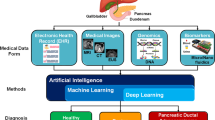Abstract
Pancreatic ductal adenocarcinoma (PDAC), the most common type of pancreatic cancer, is a leading cause of cancer death in both men and women. Early detection of PDAC is challenging and often patients are diagnosed when the cancer is well developed. Recent research has tried to establish a relationship between protein biomarker levels in urine samples and pancreatic cancer to allow non-invasive, inexpensive and possible early detection of cancer. Artificial neural networks, used to solve highly complex problems within the physical sciences, can efficiently facilitate cancer detection. This paper presents a neural network model to diagnose pancreatic cancer using four urinary biomarkers- creatinine, LYVE1, REGB1, TFF1. The model used is Radial basis function neural network (RBFNN) and is created using MATLAB software to differentiate between urine sample data of healthy people and cancer patients. It produces an accuracy of 76.5%, recall of 77% and specificity of 76% suggesting possible diagnosis of PDAC patients.


Similar content being viewed by others
Data Availability
The datasets generated during and/or analysed during the current study are available in the figshare repository https://doi.org/10.6084/m9.figshare.22138340.v2. These datasets were derived from the following public domain resources: https://www.kaggle.com/datasets/johnjdavisiv/urinary-biomarkers-for-pancreatic-cancerhttps://journals.plos.org/plosmedicine/article?id=10.1371/journal.pmed.1003489#abstract0
References
Pancreatic cancer – statistics, https://www.cancer.net/cancer-types/pancreatic-cancer/statistics#:~:text=Incidence%20rates%20of%20pancreatic%20cancer,the%20United%20States%20this%20year, last accessed 2022/08/25.
Debernardi S, O’Brien H, Algahmdi AS, Malats N, Stewart GD, Plješa-Ercegovac M, Costello E, Greenhalf W, Saad A, Roberts R, Ney A. A combination of urinary biomarker panel and PancRISK score for earlier detection of pancreatic cancer: A case–control study. PLoS Med. 2020;17(12): e1003489.
Blyuss O, Zaikin A, Cherepanova V, Munblit D, Kiseleva EM, Prytomanova OM, Duffy SW, Crnogorac-Jurcevic T. Development of PancRISK, a urine biomarker-based risk score for stratified screening of pancreatic cancer patients. Br J Cancer. 2020;122(5):692–6.
Radon TP, Massat NJ, Jones R, Alrawashdeh W, Dumartin L, Ennis D, Duffy SW, Kocher HM, Pereira SP, Guarner L, Murta-Nascimento C. Identification of a three-biomarker panel in urine for early detection of pancreatic adenocarcinoma. Clin Cancer Res. 2015;21(15):3512–21.
Li L. The Investigation of the Correlation between 4 Urine Biomarkers and Intelligent Diagnosis of PDAC. In2022 IEEE 2nd International Conference on Electronic Technology, Communication and Information (ICETCI) 2022 May 27 (pp. 593–596). IEEE.
Bhuiyan MT. An Intelligent System Model for Diagnostic of Human Pancreatic Cancer (Doctoral dissertation, The University of Regina (Canada)).
Reddy S, Chandrasekar M. PAD: A Pancreatic Cancer Detection based on Extracted Medical Data through Ensemble Methods in Machine Learning. International Journal of Advanced Computer Science and Applications. 2022;13(2).
Muhammad W, Hart GR, Nartowt B, Farrell JJ, Johung K, Liang Y, Deng J. Pancreatic cancer prediction through an artificial neural network. Front Artificial Intell. 2019;3(2):2.
Sanoob MU, Madhu A, Ajesh K, Varghese SM. Artificial neural network for diagnosis of pancreatic cancer. Int J Cybernet Inform. 2016;5(2):40–9.
Sekaran K, Chandana P, Krishna NM, et al. Deep learning convolutional neural network (CNN) With Gaussian mixture model for predicting pancreatic cancer. Multimed Tools Appl. 2020;79:10233–47. https://doi.org/10.1007/s11042-019-7419-5.
Suman G, Panda A, Korfiatis P, Goenka AH. Convolutional neural network for the detection of pancreatic cancer on CT scans. The Lancet Digital Health. 2020;2(9): e453.
Walczak S, Velanovich V. Improving prognosis and reducing decision regret for pancreatic cancer treatment using artificial neural networks. Decis Support Syst. 2018;1(106):110–8.
Arunkumar M, Murthi A, Student PG. ANN based image classifier for pancreatic cancer detection. Singapore J Sci Res. 2016;8(2):1–1.
Qureshi TA, Javed S, Sarmadi T, Pandol SJ, Li D. Artificial intelligence and imaging for risk prediction of pancreatic cancer. Chin Clin Oncol. 2022;11(1):1.
Radial basis functions neural networks - all we need to know, https://towardsdatascience.com/radial-basis-functions-neural-networks-all-we-need-to-know-9a88cc053448, last accessed 2022/08/25.
Funding
This research received no external funding.
Author information
Authors and Affiliations
Corresponding author
Ethics declarations
Conflict of interest
All authors declare that they have no conflicts of interest.
Ethical approval
All procedures performed in studies involving human participants were in accordance with the ethical standards of the institutional and/or national research committee and with the 1964 Helsinki declaration and its later amendments or comparable ethical standards.
Informed consent
Informed consent was obtained from all individual participants included in the study.
Additional information
Publisher's Note
Springer Nature remains neutral with regard to jurisdictional claims in published maps and institutional affiliations.
This article is part of the topical collection “Advances in Computational Intelligence for Artificial Intelligence, Machine Learning, Internet of Things and Data Analytics” guest edited by S. Meenakshi Sundaram, Young Lee and Gururaj K S.
Rights and permissions
Springer Nature or its licensor (e.g. a society or other partner) holds exclusive rights to this article under a publishing agreement with the author(s) or other rightsholder(s); author self-archiving of the accepted manuscript version of this article is solely governed by the terms of such publishing agreement and applicable law.
About this article
Cite this article
Upadhyay, A., Lalwaney, A. & Sharma, A. Pancreatic Cancer Detection Using Radial Basis Neural Network. SN COMPUT. SCI. 4, 261 (2023). https://doi.org/10.1007/s42979-022-01643-7
Received:
Accepted:
Published:
DOI: https://doi.org/10.1007/s42979-022-01643-7



